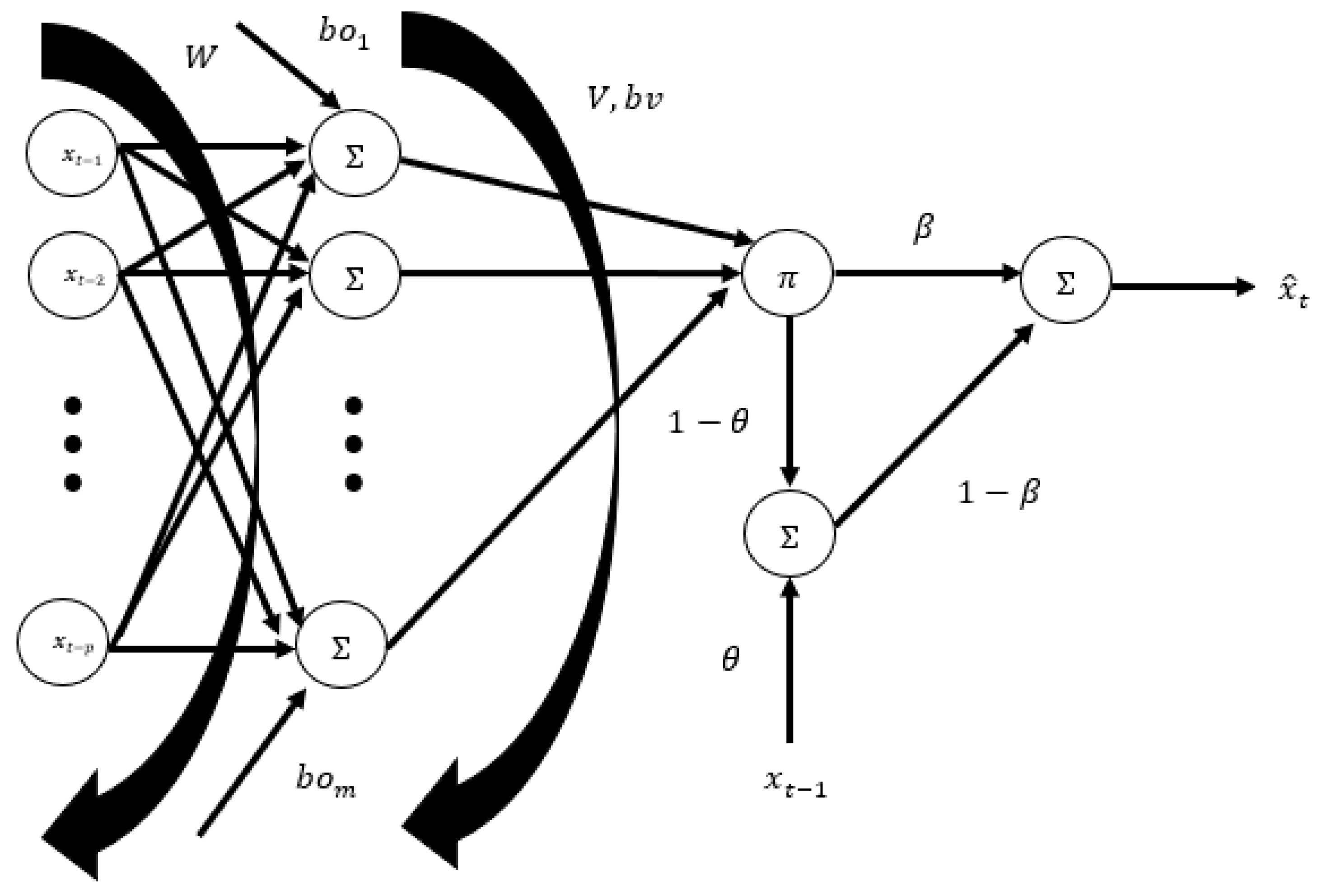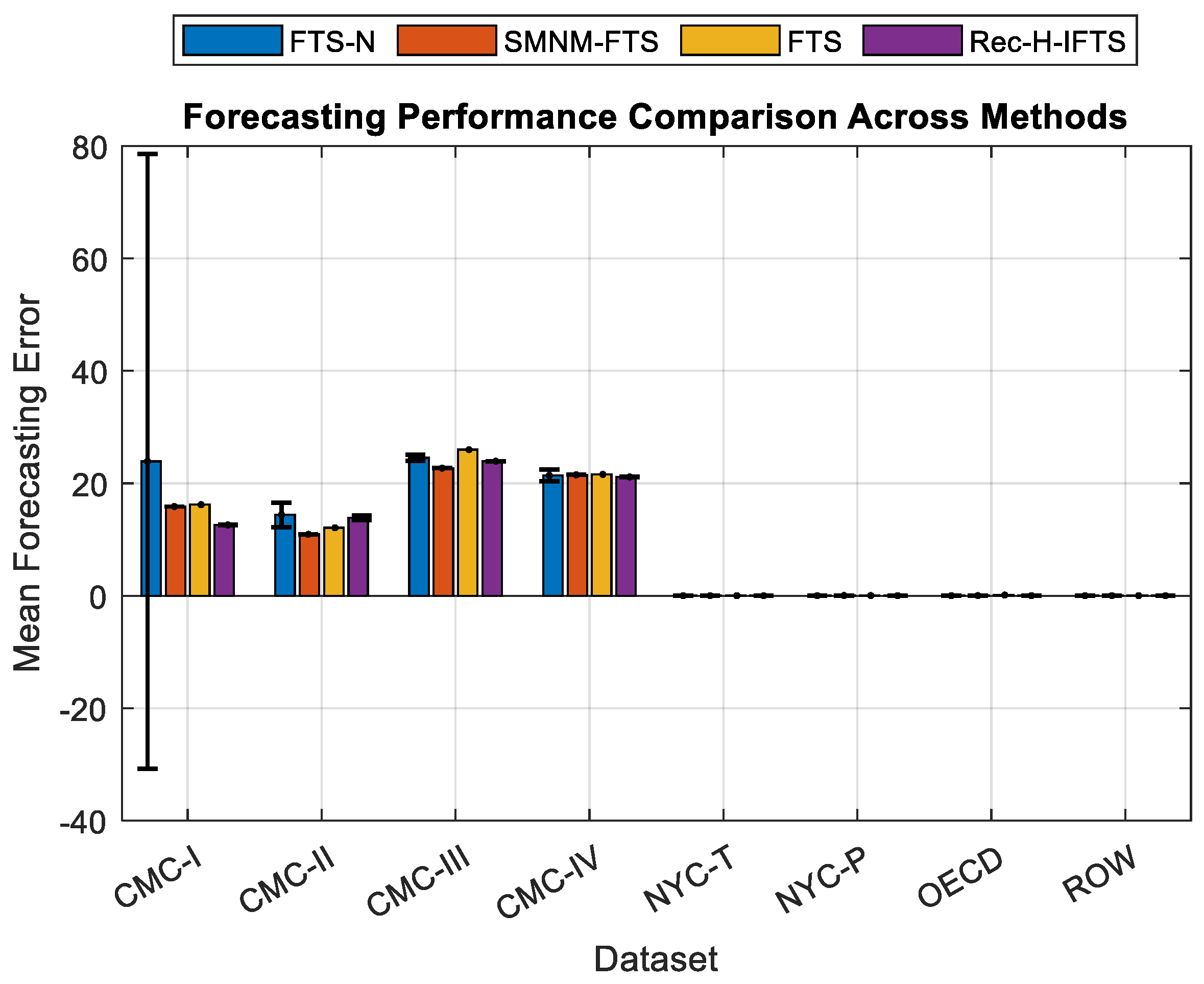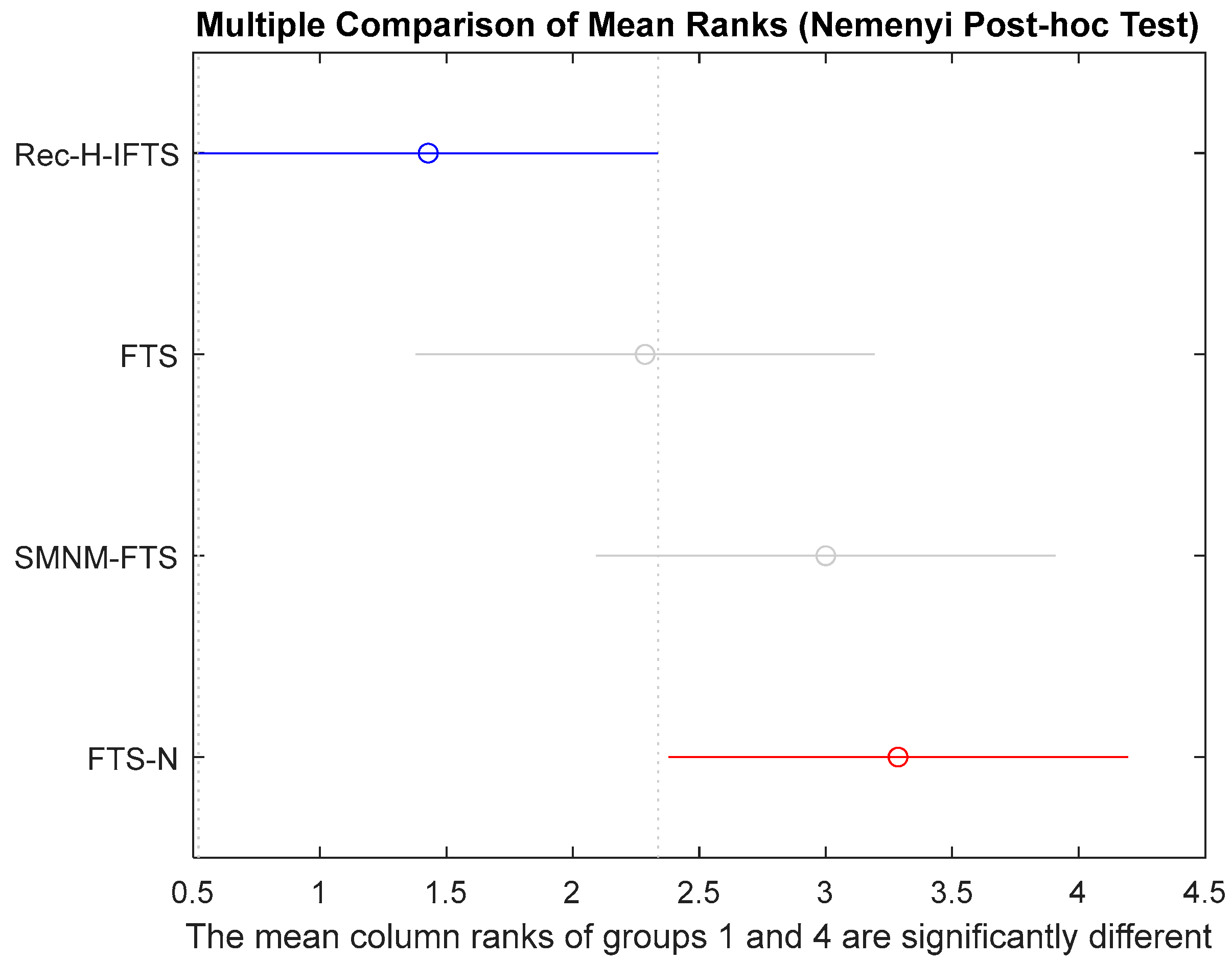A New Hybrid Recurrent Intuitionistic Fuzzy Time Series Forecasting Method
Highlights
- The first contribution of this study is the proposal of a novel artificial neural network architecture featuring a hybrid design that combines a modified Pi-sigma neural network with simple exponential smoothing.
- The second contribution is the formulation of a novel intuitionistic fuzzy time series forecasting method based on the proposed recurrent neural network.
- The proposed forecasting method demonstrates successful forecasting results across time series data belonging to the stock market and sustainable water resources. This success suggests the establishment of an effective methodology that can be utilized for forecasting time series emerging in other domains.
- The proposed new artificial neural network provides a powerful tool for generating different intuitionistic fuzzy time series forecasting methods.
Abstract
1. Introduction
2. Literature Review
3. Recurrent Hybrid Artificial Neural Network Based on Modified Pi–Sigma and Exponential Smoothing
4. The Proposed Method
- Step 1. Determine the model parameters.
- : Minimum and maximum values for the number of intuitionistic fuzzy sets;
- : Minimum and maximum values for the number of hidden-layer units of the MPS-ANN;
- Maximum number of lags;
- Maximum number of iterations;
- Minimum and maximum values for inertia weight;
- Minimum and maximum values for cognitive coefficient;
- Minimum and maximum values for social coefficient;
- Length of training set;
- Length of validation set;
- Length of test set;
- Number of particles;
- Maximum velocity value of particles.
- Step 2. The dataset is block-structured into training, validation, and test sets as given in Equations (7)–(9), respectively.
- Step 3. The transformation given in Equations (10)–(12) is used to normalize the training data.
- Step 4. The partial autocorrelation coefficients , for the time series and the variances of the partial autocorrelation coefficients are calculated for the calculations of confidence intervals by Equations (13)–(15).
- Step 5. The lags corresponding to the partial autocorrelation coefficients outside the limits of are determined. These lags form the elements of the set. The membership function of the set with is given by Equation (16).
- Step 6. Repeat Steps 7–12 for and .
- Step 7. The intuitionistic fuzzy clustering method is used to cluster the observations of the training set . The intuitionistic fuzzy clustering method in [20] is used for clustering. As a result of the clustering, membership and non-membership values of the observations in the time series to each cluster are determined. Membership () and non-membership () matrices are constructed using these values as given in Equations (17) and (18).
- Step 8. Each column of the and matrices is a time series consisting of membership values. The and matrices are created. These matrices consist of the lagged variables of these time series according to the elements of the set. For example, if and , then and are given by Equations (19) and (20).
- Step 9. The and matrices are combined to form a composite matrix, and principal component analysis is applied to this matrix. The score matrix (SM) of the principal components explaining 95% of the variance is obtained. Thus, dimension reduction and steepening operations are performed for the membership and non-membership values. The size of the matrix is from the product of the number of elements of the set and the number of fuzzy sets (n_trn), while the number of columns of the SM is and the number of rows is . In the application of principal component analysis, eigenvalues and eigenvectors are calculated on the variance–covariance matrix of the data matrix . Eigenvalues are obtained from the solution by Equation (21).
- Step 10. From the training data , according to the elements of the set, a lagged variables matrix is created. This matrix and the SM have the same number of rows.
- Step 11. The input set of the MPS-ANN is obtained by combining the matrix and the SM. The number of inputs of the ANN is . is given by Equation (23).Step 12. The PSO algorithm is used to train the RH-MPS-ANN.
- Step 12.1. Initial random velocity and positions are generated by Equations (24) and (25), respectively. What the positions of a particle represent is shown in Figure 2. The initial position and velocity values are generated from a continuous uniform distribution with parameters (0, 1).
- Step 12.2. The fitness values are calculated for all particles. The root-mean-square error (RMSE) given by Equation (26) is used as the fitness function.is calculated by Equations (27) and (28).
- Step 12.3. Pbest and gbest are generated using the fitness values.
- Step 12.4. The particle swarm optimization parameters are updated by Equations (29)–(34).
- Step 12.5. The stopping condition is checked by Equation (36). is the fitness function value calculated for gbest in the iteration, and is the counter value used to check for early stopping, with an initial value of zero. If , the algorithm is stopped; otherwise, return to Step 12.4.Step 12.6. The restart counter is checked. This counter is denoted by and has an initial value of zero. The value of the counter is incremented every iteration.
- Step 13. By calculating the forecasts corresponding to data from neural networks trained for and , the error measure given by Equation (38) is calculated for .
- Step 14. The and values that give the lowest value are determined as and .
- Step 15. Steps 7–12 are applied for and and with 30 different random initial value sets by changing the training set as given in Equation (39).
- Step 16. The error measure given by Equation (40) is computed by calculating the forecasts corresponding to the data from the networks trained 30 times for and .
- Step 17. To evaluate the performance of the method, the mean, median, standard deviation, interquartile range, and minimum and maximum statistics of for the error criterion values are calculated.
5. Applications
6. Conclusions and Discussion
Author Contributions
Funding
Data Availability Statement
Acknowledgments
Conflicts of Interest
References
- Rumelhart, D.E.; Hinton, G.E.; Williams, R.J. Learning representations by back-propagating errors. Nature 1986, 323, 533–536. [Google Scholar] [CrossRef]
- Shin, Y.; Ghosh, J. The pi-sigma network: An efficient higher-order neural network for pattern classification and function approximation. In Proceedings of the IJCNN-91-Seattle International Joint Conference on Neural Networks, Seattle, WA, USA, 8–12 July 1991; pp. 13–18. [Google Scholar]
- Egrioglu, E.; Bas, E. Modified pi sigma artificial neural networks for forecasting. Granul. Comput. 2023, 8, 131–135. [Google Scholar] [CrossRef]
- Gautam, S.S.; Singh, S.R. A score function-based method of forecasting using intuitionistic fuzzy time series. New Math. Nat. Comput. 2018, 14, 91–111. [Google Scholar] [CrossRef]
- Yang, H.; Gao, Y.; Zhao, F.; Wang, J. An intelligent interval forecasting system based on fuzzy time series and error distribution characteristics for air quality index. Environ. Res. 2024, 251, 118577. [Google Scholar] [CrossRef]
- Yu, T.H.K.; Huarng, K.H. A neural network-based fuzzy time series model to improve forecasting. Expert Syst. Appl. 2010, 37, 3366–3372. [Google Scholar] [CrossRef]
- Singh, P.; Borah, B. An efficient time series forecasting model based on fuzzy time series. Eng. Appl. Artif. Intell. 2013, 26, 2443–2457. [Google Scholar] [CrossRef]
- Wang, Y.N.; Lei, Y.; Fan, X.; Wang, Y. Intuitionistic fuzzy time series forecasting model based on intuitionistic fuzzy reasoning. Math. Probl. Eng. 2016, 2016, 5035160. [Google Scholar] [CrossRef]
- Fan, X.; Lei, Y.; Wang, Y. Adaptive partition intuitionistic fuzzy time series forecasting model. J. Syst. Eng. Electron. 2017, 28, 585–596. [Google Scholar] [CrossRef]
- Chen, L.S.; Chen, M.Y.; Chang, J.R.; Yu, P.Y. An intuitionistic fuzzy time series model based on new data transformation method. Int. J. Comput. Intell. Syst. 2021, 14, 550–559. [Google Scholar] [CrossRef]
- Pant, S.; Kumar, S. IFS and SODA based computational method for fuzzy time series forecasting. Expert Syst. Appl. 2022, 209, 118213. [Google Scholar] [CrossRef]
- Pattanayak, R.M.; Behera, H.S.; Panigrahi, S. A novel high order hesitant fuzzy time series forecasting by using mean aggregated membership value with support vector machine. Inf. Sci. 2023, 626, 494–523. [Google Scholar] [CrossRef]
- Goyal, G.; Bisht, D.C. Adaptive hybrid fuzzy time series forecasting technique based on particle swarm optimization. Granul. Comput. 2023, 8, 373–390. [Google Scholar] [CrossRef]
- Didugu, G.; Gandhudi, M.; Alphonse, P.J.A.; Gangadharan, G.R. VWFTS-PSO: A novel method for time series forecasting using variational weighted fuzzy time series and particle swarm optimization. Int. J. Gen. Syst. 2025, 54, 540–559. [Google Scholar] [CrossRef]
- Kocak, C. A new high order fuzzy ARMA time series forecasting method by using neural networks to define fuzzy relations. Math. Probl. Eng. 2015, 2015, 128097. [Google Scholar] [CrossRef]
- Rubio, A.; Bermúdez, J.D.; Vercher, E. Improving stock index forecasts by using a new weighted fuzzy-trend time series method. Expert Syst. Appl. 2017, 76, 12–20. [Google Scholar] [CrossRef]
- Wang, B.; Liu, X. Fuzzy-probabilistic time series forecasting combining Bayesian network and fuzzy time series model. Symmetry 2025, 17, 275. [Google Scholar] [CrossRef]
- Wang, B.; Liu, X.; Chi, M.; Li, Y. Bayesian network based probabilistic weighted high-order fuzzy time series forecasting. Expert Syst. Appl. 2024, 237, 121430. [Google Scholar] [CrossRef]
- Egrioglu, E.; Yolcu, U.; Bas, E. Intuitionistic high-order fuzzy time series forecasting method based on pi-sigma artificial neural networks trained by artificial bee colony. Granul. Comput. 2019, 4, 639–654. [Google Scholar] [CrossRef]
- Kocak, C.; Egrioglu, E.; Bas, E. A new deep intuitionistic fuzzy time series forecasting method based on long short-term memory. J. Supercomput. 2021, 77, 6178–6196. [Google Scholar] [CrossRef]
- Kocak, C.; Egrioglu, E.; Bas, E. A new explainable robust high-order intuitionistic fuzzy time-series method. Soft Comput. 2023, 27, 1783–1796. [Google Scholar] [CrossRef]
- Pant, M.; Bisht, K.; Negi, S. Computational-based partitioning and Strong α β-cut based novel method for intuitionistic fuzzy time series forecasting. Appl. Soft Comput. 2023, 142, 110336. [Google Scholar] [CrossRef]
- Khashe, M.; Bijari, M.; Hejazi, S.R. An extended fuzzy artificial neural networks model for time series forecasting. Iran. J. Fuzzy Syst. 2011, 8, 45–66. [Google Scholar]
- Bas, E.; Egrioglu, E.; Aladag, C.H.; Yolcu, U. Fuzzy-time-series network used to forecast linear and nonlinear time series. Appl. Intell. 2015, 43, 343–355. [Google Scholar] [CrossRef]
- Sadaei, H.J.; e Silva, P.C.D.L.; Guimaraes, F.G.; Lee, M.H. Short-term load forecasting by using a combined method of convolutional neural networks and fuzzy time series. Energy 2019, 175, 365–377. [Google Scholar] [CrossRef]
- Kumar, B.; Yadav, N. A novel hybrid model combining βSARMA and LSTM for time series forecasting. Appl. Soft Comput. 2023, 134, 110019. [Google Scholar] [CrossRef]
- Song, M.; Wang, R.; Li, Y. Hybrid time series interval prediction by granular neural network and ARIMA. Granul. Comput. 2024, 9, 3. [Google Scholar] [CrossRef]
- Zhang, J.; Tao, Z.; Liu, J.; Liu, X.; Chen, H. A hybrid interval-valued time series prediction model incorporating intuitionistic fuzzy cognitive map and fuzzy neural network. J. Forecast. 2025, 44, 93–111. [Google Scholar] [CrossRef]
- Cao, Z.; Wang, J.; Xia, Y. Combined electricity load-forecasting system based on weighted fuzzy time series and deep neural networks. Eng. Appl. Artif. Intell. 2024, 132, 108375. [Google Scholar] [CrossRef]
- Bhanja, S.; Das, A. An air quality forecasting method using fuzzy time series with butterfly optimization algorithm. Microsyst. Technol. 2024, 30, 613–623. [Google Scholar] [CrossRef]
- Feng, J.; Gong, Z. An interpretable combined forecasting method for stock market based on fuzzy time series model and linear-trend fuzzy information granulation. IEEE Access 2025, 13, 73722–73734. [Google Scholar] [CrossRef]
- Pant, S.; Kumar, S. PIFS ARC and Markov model based hybrid method for fuzzy time series forecasting. Expert Syst. Appl. 2025, 279, 127510. [Google Scholar] [CrossRef]
- Ashraf, S.; Chohan, M.S.; Askar, S.; Jabbar, N. q-Rung Orthopair fuzzy time series forecasting technique: Prediction based decision making. AIMS Math. 2024, 9, 5633–5660. [Google Scholar] [CrossRef]
- Shi, X.; Wang, J.; Zhang, B. A fuzzy time series forecasting model with both accuracy and interpretability is used to forecast wind power. Appl. Energy 2024, 353, 122015. [Google Scholar] [CrossRef]
- Aladag, C.H. Using multiplicative neuron model to establish fuzzy logic relationships. Expert Syst. Appl. 2013, 40, 850–853. [Google Scholar] [CrossRef]
- Chen, S.M. Forecasting enrollments based on fuzzy time-series. Fuzzy Sets Syst. 1996, 81, 311–319. [Google Scholar] [CrossRef]






| Time Series | Time Range | Type | p | c | Validation/Test Set |
|---|---|---|---|---|---|
| CMC-Open-I | 12/07/2022 to 13/02/2023 | Daily | 1 to 10 | 1 to 10 | 20/20 |
| CMC-Open-II | 05/04/2022 to 7/11/2023 | Daily | 1 to 10 | 1 to 10 | 20/20 |
| CMC-Open-III | 11/08/2022 to 16/03/2023 | Daily | 1 to 10 | 1 to 10 | 20/20 |
| CMC-Open-IV | 16/11/2022 to 23/06/2023 | Daily | 1 to 10 | 1 to 10 | 20/20 |
| The total water consumption in NYC | 1979 to 2019 | Annual | 1 to 12 | 1 to 10 | 4/4 |
| The per capita water consumption in NYC | 1979 to 2019 | Annual | 1 to 12 | 1 to 10 | 4/4 |
| The freshwater use in OECD countries | 1901 to 2006 | Annual | 1 to 12 | 1 to 10 | 4/4 |
| The freshwater use in ROW countries | 1901 to 2006 | Annual | 1 to 12 | 1 to 10 | 4/4 |
| Author(s) | Method |
|---|---|
| [24] | Fuzzy Time Series Network (FTS-N) |
| [35] | Fuzzy time series method based on a multiplicative neuron model (SMNM-FTS) |
| [36] | A basic fuzzy time series method (FTS) |
| Method | Mean | Std. Dev. | ||
|---|---|---|---|---|
| FTS-N | 23.9143 | 54.6751 | 5 | 1 |
| SMNM-FTS | 15.8876 | 0.0000 | 4 | 2 |
| FTS | 16.2064 | - | 5 | 4 |
| Rec-H-IFTS | 12.5980 | 0.0288 | 2 | 1 |
| Method | Mean | Std. Dev. | ||
|---|---|---|---|---|
| FTS-N | 14.3942 | 2.1703 | 8 | 3 |
| SMNM-FTS | 10.9298 | 0.0000 | 7 | 2 |
| FTS | 12.0974 | 7 | 10 | |
| Rec-H-IFTS | 13.8576 | 0.3944 | 5 | 4 |
| Method | Mean | Std. Dev. | ||
|---|---|---|---|---|
| FTS-N | 24.5454 | 0.5712 | 7 | 2 |
| SMNM-FTS | 22.7020 | 0.0000 | 6 | 2 |
| FTS | 25.9964 | 7 | 12 | |
| Rec-H-IFTS | 23.9341 | 0.0298 | 5 | 5 |
| Method | Mean | Std. Dev. | ||
|---|---|---|---|---|
| FTS-N | 21.3999 | 1.0379 | 6 | 1 |
| SMNM-FTS | 21.5219 | 0.0000 | 7 | 2 |
| FTS | 21.5754 | 7 | 12 | |
| Rec-H-IFTS | 21.1510 | 0.0555 | 4 | 3 |
| Method | Mean | Std. Dev. | ||
|---|---|---|---|---|
| FTS-N | 0.0210 | 0.0046 | 10 | 1 |
| SMNM-FTS | 0.0203 | 0.0000 | 7 | 3 |
| FTS | 0.0204 | - | 7 | 2 |
| Rec-H-IFTS | 0.0137 | 0.0043 | 3 | 1 |
| Method | Mean | Std. Dev. | ||
|---|---|---|---|---|
| FTS-N | 0.0169 | 0.0071 | 3 | 3 |
| SMNM-FTS | 0.0405 | 0.0214 | 7 | 2 |
| FTS | 0.0349 | - | 7 | 2 |
| Rec-H-IFTS | 0.0146 | 0.0135 | 3 | 3 |
| Method | Mean | Std. Dev. | ||
|---|---|---|---|---|
| FTS-N | 0.0223 | 0.0013 | 5 | 6 |
| SMNM-FTS | 0.0338 | 0.0033 | 4 | 4 |
| FTS | 0.1270 | - | 7 | 12 |
| Rec-H-IFTS | 0.0181 | 0.0049 | 4 | 1 |
| Method | Mean | Std. Dev. | ||
|---|---|---|---|---|
| FTS-N | 0.0186 | 0.0016 | 7 | 1 |
| SMNM-FTS | 0.0210 | 0.0000 | 7 | 2 |
| FTS | 0.0144 | - | 4 | 2 |
| Rec-H-IFTS | 0.0219 | 0.0001 | 3 | 2 |
Disclaimer/Publisher’s Note: The statements, opinions and data contained in all publications are solely those of the individual author(s) and contributor(s) and not of MDPI and/or the editor(s). MDPI and/or the editor(s) disclaim responsibility for any injury to people or property resulting from any ideas, methods, instructions or products referred to in the content. |
© 2025 by the authors. Licensee MDPI, Basel, Switzerland. This article is an open access article distributed under the terms and conditions of the Creative Commons Attribution (CC BY) license (https://creativecommons.org/licenses/by/4.0/).
Share and Cite
Cansu, T.; Bas, E.; Akkan, T.; Egrioglu, E. A New Hybrid Recurrent Intuitionistic Fuzzy Time Series Forecasting Method. Forecasting 2025, 7, 71. https://doi.org/10.3390/forecast7040071
Cansu T, Bas E, Akkan T, Egrioglu E. A New Hybrid Recurrent Intuitionistic Fuzzy Time Series Forecasting Method. Forecasting. 2025; 7(4):71. https://doi.org/10.3390/forecast7040071
Chicago/Turabian StyleCansu, Turan, Eren Bas, Tamer Akkan, and Erol Egrioglu. 2025. "A New Hybrid Recurrent Intuitionistic Fuzzy Time Series Forecasting Method" Forecasting 7, no. 4: 71. https://doi.org/10.3390/forecast7040071
APA StyleCansu, T., Bas, E., Akkan, T., & Egrioglu, E. (2025). A New Hybrid Recurrent Intuitionistic Fuzzy Time Series Forecasting Method. Forecasting, 7(4), 71. https://doi.org/10.3390/forecast7040071







